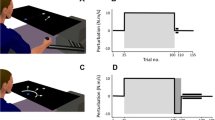Abstract
We investigated, by using simulations, possible mechanisms responsible for the errors in the direction of arm movements exhibited by deafferented patients. Two aspects of altered feedforward control were evaluated: the inability to sense initial conditions and the degradation of an internal model. A simulation which assumed no compensation for variations in initial arm configuration failed to reproduce the characteristic pattern of errors. In contrast, a simulation that assumed random variability in the generation of joint torque resulted in a distribution of handpaths which resembled some aspects of the pattern of errors exhibited by deafferented patients.
Similar content being viewed by others
References
Atkeson CG (1989) Learning arm movement kinematics and dynamics. Ann Rev Neurosci 12:157–183
Atkeson CG, Hollerbach JM (1985) Kinematic features of unrestrained vertical arm movements. J Neurosci 5:2318–2330
Bossom J (1974) Movement without proprioception. Brain Res 71:285–296
Flanders M (1991) Temporal patterns of muscle activation for arm movements in three-dimensional space. J Neurosci 11:2680–2693
Forget R and Lamarre Y (1987) Rapid elbow flexion in the absence of proprioceptive and cutaneous feedback. Hum Neurobiol 6:27–37
Georgopoulos AP, Kalaska JF, Massey JT (1981) Spatial trajectories and reaction times of aimed movements: effects of practice, uncertainty, and change of target location. J Neurophysiol46:725–743
Georgopoulos AP, Kettner RE, Schwartz AB (1988) Primate motor cortex and free arm movements to visual targets in three-directional space. II. Coding of the direction by a neuronal population. J Neurosci 8:2928–2937
Ghez C, Gordon J, Ghilardi MF, Christakos CN, Cooper SE (1990) Roles of proprioceptive input in the programming of arm trajectories. Cold Spring Harb Symp Quat Biol 55:837–847
Ghez C, Gordon J, Ghilardi MF (1993) Programming of extent and direction in human reaching movements. Biomed Res 14 Suppl 1:1–5
Hasan Z (1992) Role of proprioceptors in neural control. Curr Opin Neurobiol 2:824–829
Hasan Z, Stuart DG (1988) Animal solutions to problems of movement control: the role of proprioceptors. Ann Rev Neurosci 11:199–224
Hogan N, Flash T (1987) Moving gracefully: quantitative theories of motor coordination. Trends Neurosci 10:170–174
Hollerbach JM (1984) Dynamic scaling of manipulator trajectories. J Dyn Syst Meas Control 106:102–106
Hollerbach JM, Atkeson CG (1987) Deducing planning variables from experimental arm trajectories: pitfalls and possibilities. Biol Cybern 56:279–292
Hollerbach JM, Flash T (1982) Dynamic interactions between limb segments during planar arm movement. Biol Cybern 44:67–77
Knapp HD, Taub E, Berman AJ (1958) Effect of deafferentiation on a conditioned avoidance response. Science 128:842–843
Knapp HD, Taub E, Berman AJ (1963) Movements in monkeys with deafferented forelimbs. Exp Neurol 7:305–315
Lacquaniti F, Soechting JF, Terzuolo CA (1982) Some factors pertinent to the organization and control of arm movements. Brain Res 252:394–397
Morasso P (1981) Spatial control of arm movements. Exp Brain Res 42:223–237
Rothwell JC, Taub MM, Day BL, Obeso JA, Thomas PK, Marsden CD (1982) Manual motor performance in a deafferented man. Brain 105:515–542
Sainburg RL, Poizner H, Ghez C (1993) Loss of proprioception produces deficits in interjoint coordination. J Neurophysiol 5:2136–2147
Sanes JN, Mauritz KH, Dalakas MC, Evarts EV (1985) Motor control in humans with large-fiber sensory neuropathy. Hum Neurobiol 4:101–114
Shadmehr R, Mussa-Ivaldi FA (1994) Adaptive representation of dynamics during learning of a motor task. J Neurosci 14:3208–3224
Smith JL, Zernicke RF (1987) Predictions for neural control based on limb dynamics. Trends Neurosci 10:123–128
Soechting JF, Flanders M (1991) Deducing central algorithms of arm movement control from kinematics. In: Humphrey DR, Freund H-J (eds) Motor control: concepts and issues. Wiley, New York, pp 293–306
Soechting JF, Lacquaniti F (1981) Invariant characteristics of a pointing movement in man. J Neurosci 1:710–720
Taub E, Berman AJ (1963) Avoidance conditioning in the absence of relevant proprioceptive and exteroceptive feedback. J Comp Physiol Psychol 56:1012–1016
Author information
Authors and Affiliations
Rights and permissions
About this article
Cite this article
Buneo, C.A., Boline, J., Soechting, J.F. et al. On the form of the internal model for reaching. Exp Brain Res 104, 467–479 (1995). https://doi.org/10.1007/BF00231981
Received:
Accepted:
Issue Date:
DOI: https://doi.org/10.1007/BF00231981




